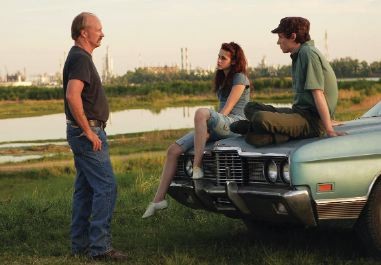The Yellow Handkerchief

Set in rural Louisiana, Udayan Prasad’s tender, affecting road picture The Yellow Handker chief combines a coming-of-age narrative with the tale of a man driven to seek the salvation he believes he no longer deserves.
Brett (William Hurt) has just been released from prison. A ferry ride and a fierce rainstorm bring him alongside two teenagers, Martine (Kristen Stewart) and Gordy (Eddie Redmayne). Gordy is new to the community, and along with his obvious crush on Martine he possesses an awkwardness that makes him more assertive than he means to be. When the circumstances force Martine and Brett to accept a ride from Gordy, Brett finds himself playing the role of chaperone.
Erin Dignam’s screenplay, based on a Pete Hamill story, intercuts this story with a series of flashbacks focused on Brett’s courtship of May (Maria Bello), whom he meets during his itinerant oil-rigging days. The filmmakers smartly put us squarely on Brett’s side early in the film. His handling of the adolescents balances sensitivity, insight and common sense. He sees that Martine’s bravado masks insecurity and tentativeness about who she is and that this mix of qualities sways her judgment, and he spots the sweetness beneath Gordy’s tendency to try too hard. Brett helps place these kids well on the path to maturity—and later they return the favor, becoming the catalysts for his finding his way back into the life that jail time derailed.
Sometimes a foreign eye can make us see our own country and culture afresh. Prasad, an Anglo-Indian filmmaker, collaborates with the brilliant British cinematographer Chris Menges to lead us into an utterly convincing Deep South countryside that doesn’t look or feel anything like that of other movies. It’s intimate and lyrical in a way that recalls Faulkner’s South, but it’s clearly contemporary. There are magical images that play over and over in your head: a burst of light like fireworks along a cityscape on the far side of a hazy river, cars chasing down a highway after a runaway horse.
Dignam’s script passes the most important test: it creates believable, original characters. She doesn’t always fill in the episodes enough, and she hasn’t figured out how to move fluidly from one sequence to the next. But it turns out not to matter much, since Prasad and the actors bring it all together for her.
In Hurt’s first scene—in which Brett walks into a convenience store hash joint and orders his first beer in six years—the actor’s authenticity and emotional precision catch you up and take you by surprise. Finally throwing off the mannered, ostentatious style that has made his recent performances so bogus, he does his finest acting in a decade and a half—ever since he played the lonely Welsh storekeeper who adopts a disturbed boy in Second Best, a neglected but beautiful little film directed by Menges.
Hurt’s flashback scenes with the marvelous Bello evoke a warmth in Hurt he may never have shown before. And no wonder: you’d have to wonder about anyone who couldn’t melt under the heat of this woman’s love. She’s the film’s touch of grace, the signpost that you feel (and the kids feel, just from hearing him speak of her) he must find again lest he always be a ghost haunting his own life.
Stewart registers every one of Mar tine’s complicated array of adolescent feelings: Martine may not understand what’s going on in her own head, but Stewart’s performance is a model of emotional clarity. At first Redmayne’s acting seems overwrought and cluttered, but he grows on you. As Gordy becomes more comfortable with Martine, he quiets down. You really begin to understand the character in the scene in which his car hits a deer and you realize, as he murmurs a native prayer over the dead animal, that the stories he has been telling Martine about himself aren’t the attention-seeking whoppers we’ve assumed them to be. The Yellow Handkerchief is a work of constant discovery and rediscovery.


